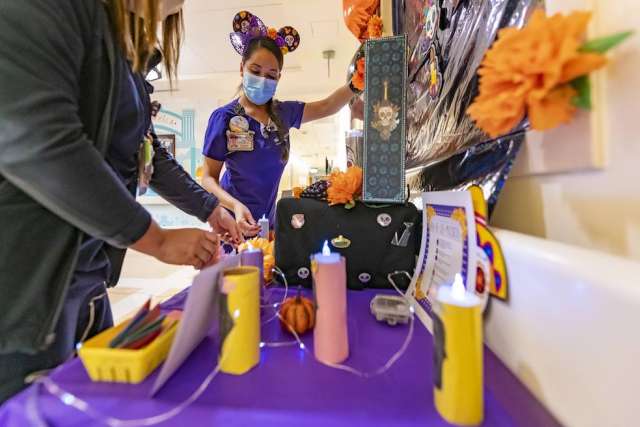Photo: Tracy Reyes, BA, CCLS, left, and Shanna Tiemens, RN, BSN, CPN, right, assemble an ofrenda for Día de los Muertos at the Mattel Children's wing at UCLA Santa Monica Medical Center on Monday, November 1, 2021. (Photo by Joshua Sudock | UCLA Health)
For the last 3 years, Tracy Reyes, Child Life Specialist at UCLA Mattel Children’s Hospital and member of La Comunidad, has set up a Día de los Muertos (Day of the Dead) altar on the pediatric floor at the UCLA Mattel Children's Hospital.
The altar showcases a commemorative Barbie, which Reyes says depicts La Calavera Catrina, or “the elegant skeleton,” with respect and beauty.
“This inclusion within the Mattel brand is huge for our Latinx community,” Reyes says of the Barbie. “It pays homage to our culture and our traditions.”
Reyes uses the altar to teach others about Día de los Muertos and show that it is more than just “sugar skulls and face paint.”
Día de los Muertos is one of Mexico’s most widespread traditions, with roots dating back 3,000 years. This spiritual and cultural tradition takes place on Nov. 1 and 2 and honors the lives of deceased ancestors and family members.
It is mostly associated with calaveras or skull and skeleton iconography, colorfully decorated altars, marigold flowers and candles. Individuals and families leave offerings like Mexican sweet bread and food, beverages, candles and flowers at the altars, which are typically created in homes, or at the cemetery.
“Día de los Muertos is a way to connect with our loved ones who have passed. It is a connection to our ancestors who taught us that for these two days, those we lost come back to us,” Reyes says. “They are greeted with our ofrenda serving them their favorite food and drink.”
Previously celebrated by the Aztec, Toltec and Nahua peoples in early August according to the ancient Aztec solar calendar, the event was later moved to Nov. 1 and 2 when Spanish colonizers attempted to impose Catholicism on Indigenous groups. As early as the 16th century, they documented the role that the Aztec marigold flower, also known as cempasúchil, played in Aztec medicines and celebrations.
The use of marigolds in this celebration is tied to an ancient fable of two lovers, Xótchitl and Huitzilin, who would often leave flower offerings atop a mountain for the sun god, Tonatiuh.
The legend says when Huitzilin was killed in battle, Xótchitl prayed to the sun god to reunite them on Earth. Tonatiuh granted her wish by transforming her into the flower and reincarnating her lover as a hummingbird.
Today, many believe the flower helps to guide their loved ones back to the living world “through the marigold flower pathway,” Reyes says.
“While death is the prominent theme of Día de los Muertos, we are celebrating the love and respect we continue to have for our loved ones on the other side,” she says. “What many may see as scary depictions of skeletons, we see as an opportunity to tell our loved ones that we miss them and we continue to hold their memory close to our hearts.”
Part of Reyes’ tradition to honor her father is to create an altar at her home filled with all his favorite things.

“My ofrenda consists of my dad's “Tres Flores Brilliantine” (hair pomade), a packet of Marlboros, a glass coke bottle and some donuts,” she says.
“I want to make sure that when he crosses back, he has everything he'd look for. I miss you papa.”
Additional traditions include storytelling, baking and dressing in costume.
Nydia Flores, member of La Comunidad and senior administrative analyst in the Office of the Chief Administrative Officer for UCLA Department of Pediatrics, bakes pumpkin muffins and makes chocolate caliente (hot chocolate) with her 10-year-old son.
“I share with him that pumpkins are native to Mesoamerica, and the oldest published domesticated pumpkin seeds were excavated by archeologists in the Highlands of Oaxaca, Mexico,” Flores says. “I also share stories of the origins of chocolate, again in Mesoamerica.
“When I was little, my dad would tell me and my brother stories about how different Mesoamerican cultures like the Aztecs, Olmecs and Mayans used cacao. It gave me pride in my ancestral roots,” she says. “By sharing these stories, I hope my son too will find pride in his ancestral roots.”
Flores shares her recipes with the greater UCLA Health community and encourages all to celebrate Día de los Muertos:
Calabaza Muffins
1 ¾ cups of all-purpose flour
1 cup sugar
½ cup dark brown sugar
1 tsp baking soda
½ tsp salt
2 tsps cinnamon
¼ tsp nutmeg
2 eggs
1 15-oz can pure pumpkin puree
½ cup coconut oil, melted
1 tsp vanilla extract
Instructions:
- Preheat oven to 375 degrees Fahrenheit (in my case my oven is rebellious, so I set to 370) and place paper muffin liners into a muffin baking pan.
- Mix the dry ingredients in a bowl and set aside.
- Whisk the eggs and the wet ingredients together.
- Pour the wet ingredients into the dry ingredients and stir until just everything is mixed, but do not overmix.
- Begin to create scoops out of the mix and place into individual muffin liners.
- Bake for 20-22 minutes.
Chocolate Mexicano
2 cups of 1% milk (okay to substitute soy, oat, etc.)
1 cup of chocolate chips
Instructions:
- Pour milk into a large pan.
- Turn on low heat.
- Crumple chocolate into pan.
- Mix with spoon until chocolate is melted (do not allow to boil).
- If you own a frother, froth chocolate & enjoy!



